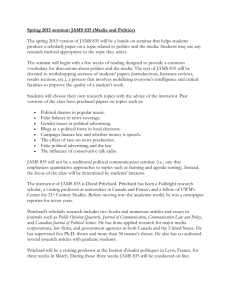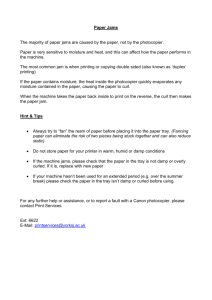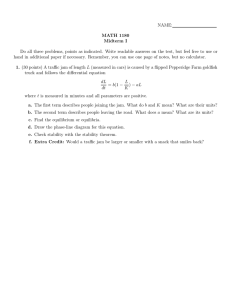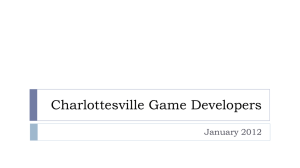Hackademics: A Case for Game Jams At Academic Conferences Michael Cook Gillian Smith
advertisement
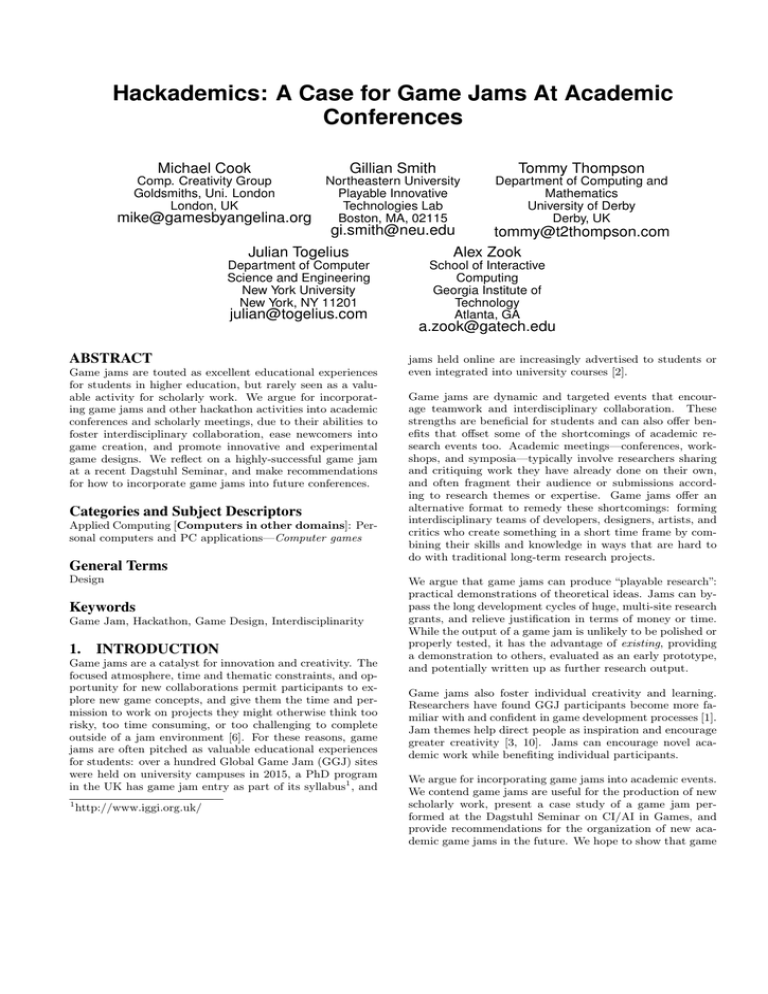
Hackademics: A Case for Game Jams At Academic Conferences Michael Cook Gillian Smith Tommy Thompson Comp. Creativity Group Goldsmiths, Uni. London London, UK Northeastern University Playable Innovative Technologies Lab Boston, MA, 02115 Department of Computing and Mathematics University of Derby Derby, UK mike@gamesbyangelina.org gi.smith@neu.edu Julian Togelius Department of Computer Science and Engineering New York University New York, NY 11201 julian@togelius.com ABSTRACT Game jams are touted as excellent educational experiences for students in higher education, but rarely seen as a valuable activity for scholarly work. We argue for incorporating game jams and other hackathon activities into academic conferences and scholarly meetings, due to their abilities to foster interdisciplinary collaboration, ease newcomers into game creation, and promote innovative and experimental game designs. We reflect on a highly-successful game jam at a recent Dagstuhl Seminar, and make recommendations for how to incorporate game jams into future conferences. Categories and Subject Descriptors Applied Computing [Computers in other domains]: Personal computers and PC applications—Computer games General Terms Design Keywords Game Jam, Hackathon, Game Design, Interdisciplinarity 1. INTRODUCTION Game jams are a catalyst for innovation and creativity. The focused atmosphere, time and thematic constraints, and opportunity for new collaborations permit participants to explore new game concepts, and give them the time and permission to work on projects they might otherwise think too risky, too time consuming, or too challenging to complete outside of a jam environment [6]. For these reasons, game jams are often pitched as valuable educational experiences for students: over a hundred Global Game Jam (GGJ) sites were held on university campuses in 2015, a PhD program in the UK has game jam entry as part of its syllabus1 , and 1 http://www.iggi.org.uk/ tommy@t2thompson.com Alex Zook School of Interactive Computing Georgia Institute of Technology Atlanta, GA a.zook@gatech.edu jams held online are increasingly advertised to students or even integrated into university courses [2]. Game jams are dynamic and targeted events that encourage teamwork and interdisciplinary collaboration. These strengths are beneficial for students and can also offer benefits that offset some of the shortcomings of academic research events too. Academic meetings—conferences, workshops, and symposia—typically involve researchers sharing and critiquing work they have already done on their own, and often fragment their audience or submissions according to research themes or expertise. Game jams offer an alternative format to remedy these shortcomings: forming interdisciplinary teams of developers, designers, artists, and critics who create something in a short time frame by combining their skills and knowledge in ways that are hard to do with traditional long-term research projects. We argue that game jams can produce “playable research”: practical demonstrations of theoretical ideas. Jams can bypass the long development cycles of huge, multi-site research grants, and relieve justification in terms of money or time. While the output of a game jam is unlikely to be polished or properly tested, it has the advantage of existing, providing a demonstration to others, evaluated as an early prototype, and potentially written up as further research output. Game jams also foster individual creativity and learning. Researchers have found GGJ participants become more familiar with and confident in game development processes [1]. Jam themes help direct people as inspiration and encourage greater creativity [3, 10]. Jams can encourage novel academic work while benefiting individual participants. We argue for incorporating game jams into academic events. We contend game jams are useful for the production of new scholarly work, present a case study of a game jam performed at the Dagstuhl Seminar on CI/AI in Games, and provide recommendations for the organization of new academic game jams in the future. We hope to show that game jams are easy to integrate into existing academic event formats, and can give rise to new and interesting work that we believe would be unlikely to come about any other way. mentary and teaching how to critique games, through improving understanding of the limitations and affordances of current game development tools. 2. Academics who do not come from development backgrounds and have no digital game creation experience may feel illequipped to create an entire game themselves even if they wish to do so. Participating in a game jam that has a thematic and temporal constraint can encourage people who have not made games before to try something new. Further, encouraging the creation of non-digital games can overcome technical hurdles and engage everyone in the design process. WHY GAME JAMS IN ACADEMIA? Game jams can benefit scholarly research as a whole, individual participants at the personal and professional levels, and even the established game jam culture. Game jams are highly interdisciplinary events, bringing together people from a variety of technical, artistic, and humanistic backgrounds. For example, at the recent GGJ at Northeastern University, one team consisted of students from an art college, students from a technically-focused degree program, and a faculty member from the School of Law. Though conferences often aim to promote interdisciplinarity, this primarily occurs by accepting papers from a variety of disciplines and presenting them in disciplinary-focused tracks. A game jam brings together people from different disciplines to collaborate in an intense and focused environment. By encouraging participants to build something with members of other disciplines there is great potential for new collaborations and learning from those in other fields. This comes through combining game development skills (such as artists and designers working with programmers and musicians), combining research expertise, and mixing cutting-edge ideas that would normally never mix. Building games and other playable experiences is a reflective process, allowing the designer(s) to deeply investigate the concepts addressed by the game through the process of making the concepts concrete in the game’s design [5, 7]. Having academics who often do not create games in their scholarly work participate in game jams creates the opportunity to bring deep domain expertise to the process, and for encouraging critical making in game design in a conference setting (as has been done outside of game design [8]). While this critical reflection may not occur until after the jam, the shared experiences and products offer the potential to develop scholarly research. Game jams force consideration of pragmatic concerns: from a game technology perspective, a system that works well in theory or even in the typically small sandbox environment used for evaluation may not readily integrate into a full working game. When designers, developers, artists, musicians, and theorists come together to make a game, each must represent their own constraints and respect each others’. For example, a procedural content generator must be able to work with the kind of art assets needed for the game to create the experience desired by a designer. While publication pressure drives academics to focus on an isolated research questions, interdisciplinary collaboration fosters attention to the notion of the product as a game. Many academics not only research games and game technology, but also teach students who are interested in making games. By participating in a game jam, academics gain practical experience with the pragmatic side of game development: understanding how different tools and game engines work and working through team dynamics. Experiencing and keeping up with contemporary game development practices is crucial for teaching students how to make games. It also helps humanists who focus on critical com- Finally, game jams can help overcome some of the risk aversion so common to academic study. In many areas, there is an incentive to pursue large grants with well-defined research questions and evaluation criteria, limiting the ability for researchers to try small and experimental projects due to a lack of funding. Grant applications typically require pre-developed systems or preliminary results, limiting researchers’ ability to explore new ideas without a wellplanned, long-term road map. Game jams offer the potential for researchers to collaborate and build small, proof-ofconcept systems in a safe and supportive environment. Beyond game jams embedded in conferences, it can also be helpful for academics to participate in other jams from the larger game community. Game jams are important community events within game development circles and even some sub-communities of players, who follow the development of the jam entries and explore the sometimes thousands of entries. This means game jams offer the unique opportunity to interact with amateur game developers and a games-playing audience. Entering these jams as academics provides a new form of outreach—offering insight into how researchers work and how their techniques can be applied to games, and providing concrete, playable examples of new ideas. Public game jams can also offer unique platforms for experimentation in some research areas such as automated game design and procedural content generation [2]. This section has highlighted major reasons game jams are useful events from a scholarly perspective and have promise for successful embedding in game conferences. The remainder of this paper describes game jams held at a recent Schloss Dagstuhl seminar and offers recommendations for hosting game jams at future academic meetings. 3. CASE STUDY: DAGSTUHL SEMINAR As a case study of academic hackathons we will discuss several activities from the Schloss Dagstuhl Seminar 15051, entitled Artificial and Computational Intelligence in Games: Integration [4]. The event was held at Schloss Dagstuhl, a research retreat in Germany that hosts week-long seminars on research frontier topics. This seminar convened researchers and industry representatives to discuss new directions for game research at the intersection of different AI areas. During the seminar two types of game jam events occurred: informal coding sessions in the evenings and a planned daylong “hackathon” session. The hackathon occurred on the fourth day of the seminar, after all 45 participants had spent time in two different discussion groups (each with 3-8 partic- ipants). During the hackathon, self-organized groups worked on small projects together, with many implementing ideas that had been proposed in prior discussion. One group implemented and compared a variety of AI techniques for the RTS game Planet Wars2 .An agent based on a simple AI technique proved highly successful and was in itself a novel research finding. The participants noted this had been a first for their community: pitting neural networks, Monte Carlo Tree Search and rule-based agents against one another for the first time. These successes highlight the interdisciplinary value of the hackathon, and resulted in proposals for hybrid systems to combine multiple approaches. Some attendees worked on their own projects, including: a game generator that produced mini-games that represented people and debates being held at the seminar, a sonification of character reasoning in an experimental AI-based game, methods for using MCTS in procedural content generation, or using reversed deep neural networks for representing content. Another group designed an AI-based political game about the turbulent seventies in Italy. In all, this presented an opportunity to take many of the ideas that had been proposed in the seminar and for the first time confront them with reality, or at least a compiler. Below we focus on two games we implemented during the seminar: with the latter created during the “official” hackathon phase and the other in two evenings prior. Each game arose from discussions among several of the authors about the potential applications of AI in game design. A summary of this discussion and key contributions can be found in [9]. 3.1 Game Jam #1: Contrabot Contrabot originated from group discussions on the notion of design patterns for artificial intelligence (AI) in games. After a day of discussion, several members of the group spent the evening developing the first working implementation of a game based on ‘fooling’ an AI system that uses machine learning. While we focus on the hackathon experience, further details on the design rationale and gameplay of Contrabot can be found in [9]3 . Contrabot illustrates how to adopt a specific AI-based game design pattern and expresses the concepts and theories of the discussion group. Our development experience encouraged scholarly discussion as we worked through design issues in representing an AI algorithm to the player while creating engaging gameplay. We also needed to address common challenges in team work including code source control, creating art assets, and visual design—all topics beyond the purview of traditional ‘academic’ roles in implementing a learning algorithm (and possibly game logic). Our experiences developing Contrabot furthered discussions on how learning algorithms can be taught (and tricked) and how AI learning provides gameplay opportunities for players. 3.2 Game Jam #2: What Did You Do? The second jam game, What Did You Do?, emerged from further discussion among the group about AI-based game design that followed from the work on Contrabot. We What Did You Do? developed with contributions by other members of the AI-based game design work group [9]4 . This project was larger and longer: incorporating a larger team and spanning several evenings and the hackathon day during the seminar. Many academics worked together a wider range of features including hand-drawn art, voice recording, and controller input. In contrast to Contrabot there was longer formative discussion on the design of What Did You Do? with substantial feature planning. Ultimately, we did not implement all of the desired functionality during the hackathon. While a failure in achieving the design goals, this resulted in continued collaboration after the seminar ended: with discussion of how best to complete the game and what contributions could still be made to the project. What started as another opportunity to highlight AI-driven game design, resulted in ongoing collaboration among academics that reinforces the original discussion and produces tangible artifacts to share with the community. The game demonstrated to Dagstuhl attendees resulted from pragmatic feature-cutting: a valuable experience echoed by game developers5 as an integral part of getting something finished, and a valuable lesson researchers rarely have. 4. RECOMMENDATIONS Based on our experiences we provide recommendations for including a game jam or hackathon in an academic context. Advertise game jams as an optional activity. Game jams should be presented to attendees similarly to workshops: a separate activity taking place on site during the main event that attendees can join should they feel inclined. Encourage open collaboration. Team formation should be free-form, with no set size or structure to group demographics. This promotes an environment that allows professionals and scholars at all levels (from student to tenured professor) to work together in a welcoming environment. Provide physical space. Provide a open space to allow a variety of working arrangements among contributors, with power and internet access. This allows groups to form in the event they wish to focus on particular activities. Use time frames instead of deadlines. A block of time should be set for the jam, with an (optional) opportunity to showcase work. This can either be within the jamming community or at a presentation session during the main event (the tactic adopted in Schloss Dagstuhl 15051). Focus on goals. Participants should focus on the elements of their intended product that are relevant to the original 2 http://planetwars.aichallenge.org/ 3 The game and source code are available at: github.com/gamesbyangelina/contrabot http:// 4 The source code for this project is available at:http:// github.com/gamesbyangelina/whatareyoudoing 5 http://makegames.tumblr.com/post/4061040007/the-fullspelunky-on-spelunky concept. This may result in artifacts that lack polish or refinement, but these issues can be resolved after the jam has been completed. While difficult to institute from an organizational perspective, we hope this ethic will grow as more academic events incorporate jams and academics are exposed to the format. Encourage post-jam development. In many cases, these projects can be expanded upon in the future should the team continue to be enthusiastic towards them. 5. CHALLENGES Incorporating game jams into academic events involves overcoming challenges in the time needed for the event and resources required for game development. Time Consumption. Game jams are often time constrained, with a typical length of 48 hours where many entrants work for 30-40 hours. Academic events are often timeconstrained as attendees may have traveled long distances and only for a few days. Dagstuhl offered ample time to work, but even half a day in a conference schedule is a small time window to produce games in (and replaces up to a dozen potential talk slots). We believe this may require a shift in the hackathon culture for such events, where the scheduled time is seen as a ‘kickoff’ phase, with projects continued in social hours throughout the event. Additionally, many jams take place in much smaller time frames, such as the 0-Hour Game Jam6 —they simply require a different approach and different prioritization, something which can be worked on and developed through future hackademic events. Resources. Game jams thrive on collaboration between differently skilled individuals, however academic events tend to collect people with similar skills from a game development standpoint (the interdisciplinary benefit comes from their varied academic backgrounds). This means that groups without artists, musicians or designers will be common at many events—we were fortunate at Dagstuhl to be assisted by an artist who produced assets for What Did You Do? Game jam entries do not need art or music, but they can make people feel easier about sharing and presenting their work. This problem can be mitigated by increasing the awareness of free resources such as Incompetech7 or Open Game Art8 . Providing resources in advance can boost confidence and overcome apprehension in people new to jamming. 6. CONCLUSIONS This paper provides an argument for the inclusion of games jam and ‘hackathon’ events as part of the program and ethos of games-driven academic conferences. We argue for the relevance and value of these activities within existing academic conferences, with examples of successful practice and recommendations for how to provide similar activities for organizational committees to consider. 6 http://0hgame.eu/ http://incompetech.com/ 8 http://opengameart.org/ 7 Game jams can provide real intellectual currency and enhance our discussions of research problems that are still not yet fully formulated or otherwise established. Jams also offer wide-ranging individual benefits: personal growth through collaboration, developing research prototypes, and gaining game development experience relevant to pedagogy. In addition to fostering creativity, encouraging open collaboration and potential inter-disciplinary research it is important to recall above all else: game jams are fun! 7. ACKNOWLEDGMENTS The authors wish to acknowledge Adam Smith from the Contrabot team, as well as Mirjam Eladhari and Antonios Liapis for their contributions to What Did You Do? This paper is a direct result of collaborations begun at Schloss Dagstuhl seminar 15051 in January 2015. The authors thank the Dagstuhl organizers and staff for their support. 8. REFERENCES [1] A. Arya, J. Chastine, J. Preston, and A. Fowler. An international study on learning and process choices in the global game jam. International Journal of Game-Based Learning, 3(4):27–46, 2013. [2] M. Cook. Make something that makes something: A report on the first procedural generation jam. In International Conference on Computational Creativity, 2015. [3] A. Kultima and K. Alha. Using the VNA ideation game at Global Game Jam. In DiGRA: Think Design Play, 2011. [4] S. M. Lucas, M. Mateas, M. Preuss, P. Spronck, and J. Togelius. Artificial and computational intelligence in games (dagstuhl seminar 15051). Dagstuhl Reports, to appear. [5] M. Mateas. Expressive AI: A hybrid art and science practice. Leonardo, 34(2):147–153, 2001. [6] J. Musil, A. Schweda, D. Winkler, and S. Biffl. Synthesized essence: what game jams teach about prototyping of new software products. In ACM/IEEE International Conference on Software Engineering, volume 2, pages 183–186. IEEE, 2010. [7] D. A. Schön. The reflective practitioner: How professionals think in action. Basic books, 1983. [8] K. Tanenbaum, J. G. Tanenbaum, A. M. Williams, M. Ratto, G. Resch, and A. Gamba Bari. Critical making hackathon: Situated hacking, surveillance and big data proposal. In CHI ’14 Extended Abstracts on Human Factors in Computing Systems, CHI EA ’14, pages 17–20, New York, NY, USA, 2014. ACM. [9] M. Treanor, A. Zook, M. P. Eladhari, J. Togelius, G. Smith, M. Cook, T. Thompson, B. Magerko, J. Levine, and A. Smith. AI-based game design patterns. In International Conference on the Foundations of Digital Games, 2015. [10] A. Zook and M. O. Riedl. Game conceptualization and development processes in the global game jam. In Inaugural Workshop on the Global Game Jam, 2013.
